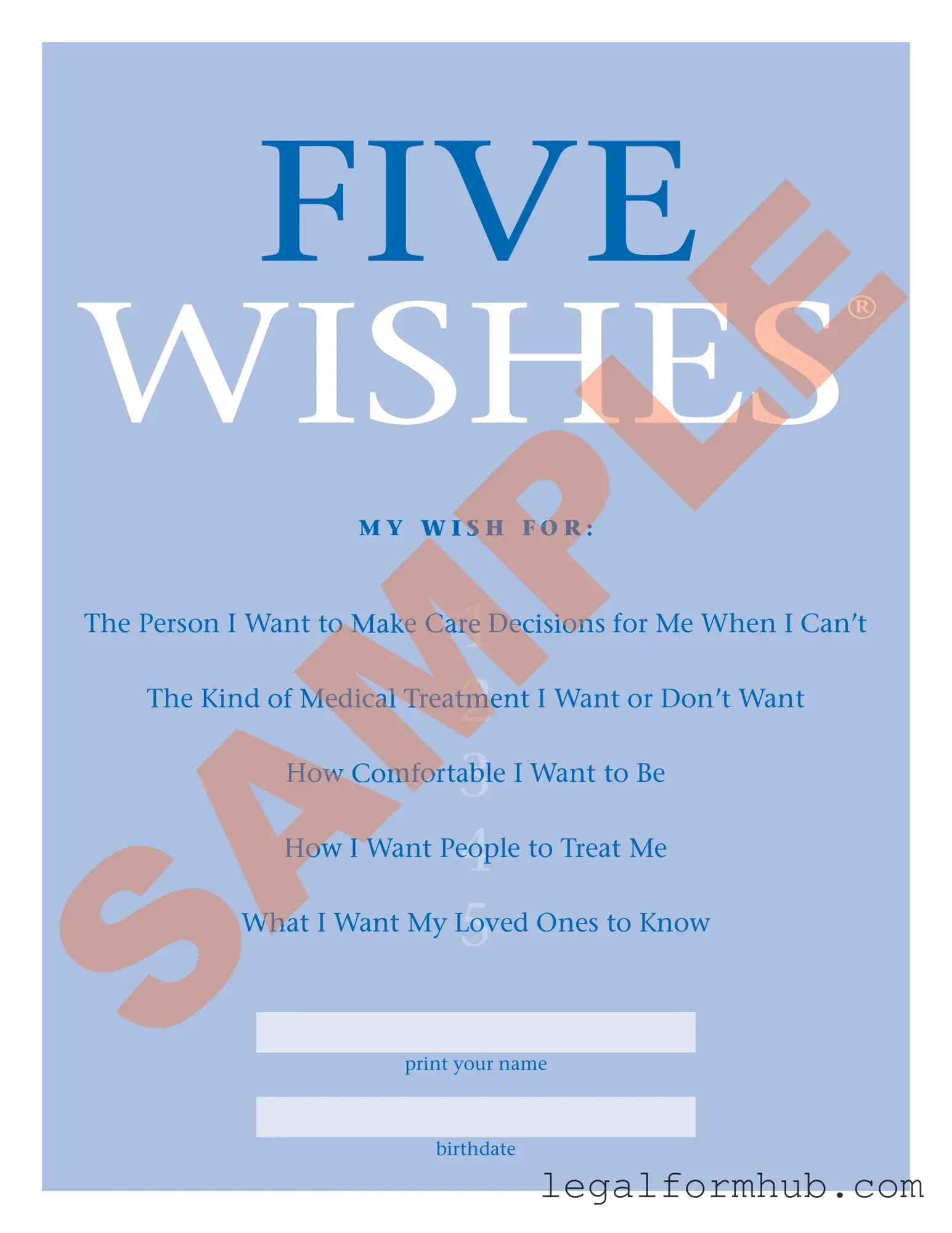The Advance Healthcare Directive is a legal document that allows individuals to outline their preferences for medical treatment in the event that they are unable to communicate their wishes. Similar to the Five Wishes document, it enables individuals to designate a healthcare proxy who will make decisions on their behalf. Both documents emphasize the importance of clear communication regarding personal values and treatment preferences, ensuring that loved ones are aware of the individual's desires during critical moments.
The Living Will serves as a directive that specifies the types of medical treatment an individual does or does not want if they become incapacitated. Like Five Wishes, it addresses medical decisions but typically focuses more narrowly on life-sustaining treatments. While Five Wishes encompasses emotional and spiritual needs, a Living Will is primarily concerned with medical interventions, making it a more straightforward option for those who want to limit the scope of their directives.
The Durable Power of Attorney for Healthcare allows a person to appoint someone to make healthcare decisions on their behalf if they are unable to do so. This document shares similarities with Five Wishes in that it designates a healthcare agent. However, it may not provide the same level of detail regarding personal wishes and values, which are central to the Five Wishes framework. This makes Five Wishes a more comprehensive choice for those wanting to convey their holistic preferences.
The Do Not Resuscitate (DNR) Order specifically addresses the individual's wishes regarding resuscitation efforts in the event of cardiac arrest or respiratory failure. While Five Wishes covers a broader range of medical decisions, a DNR focuses solely on the desire to forgo CPR and other life-saving measures. Both documents reflect the importance of respecting an individual’s choices, but they do so in different contexts.
The Physician Orders for Life-Sustaining Treatment (POLST) form is designed for individuals with serious illnesses who wish to have their treatment preferences honored. Similar to Five Wishes, it translates the individual’s wishes into actionable medical orders. However, POLST is often used in conjunction with a healthcare provider and is more clinical in nature, whereas Five Wishes places a greater emphasis on personal values and family discussions.
The Health Care Proxy form allows individuals to appoint someone to make medical decisions for them if they cannot do so. This document is akin to the healthcare agent designation in Five Wishes. However, it typically does not include the detailed preferences regarding treatment and care that Five Wishes provides. This makes Five Wishes a more thorough option for those who want to ensure their values are clearly articulated.
The End-of-Life Care Plan is a document that outlines preferences for care during the final stages of life. Like Five Wishes, it allows individuals to express their desires regarding comfort measures and emotional support. However, the End-of-Life Care Plan may focus more specifically on the final moments and less on the broader context of healthcare decisions, making Five Wishes a more comprehensive tool for planning overall healthcare preferences.
The Non-disclosure Agreement (NDA) serves a crucial role in protecting sensitive information that may be shared in various contexts, including business negotiations and personal dealings. It establishes a legal framework where parties can freely discuss and collaborate without the fear of their confidential information being unveiled. For those looking to understand the process of creating such a document, resources like https://arizonapdfs.com/non-disclosure-agreement-template/ can provide valuable templates and guidance.
The Grief and Loss Planning document assists families in navigating the emotional aspects of end-of-life care. While Five Wishes primarily addresses medical and personal treatment preferences, both documents recognize the importance of emotional well-being. They aim to provide support to families during challenging times, though the Grief and Loss Planning document may not cover medical directives as thoroughly as Five Wishes.
The Spiritual Care Directive allows individuals to express their spiritual needs and preferences related to end-of-life care. This document complements the Five Wishes by addressing the emotional and spiritual dimensions of care. While Five Wishes includes these aspects, the Spiritual Care Directive may offer a more focused approach for those who want to ensure their spiritual beliefs are honored in medical settings.
